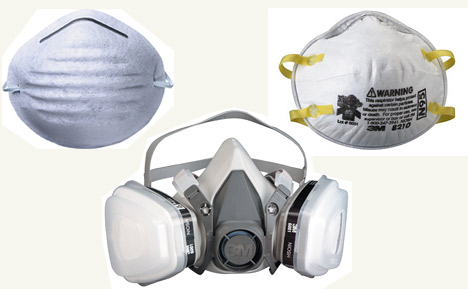Dust Mask, N95, or Respirator

What is the difference between an ordinary dust mask, N95 mask, and respirator? The answer is important to understand.
First, a dust mask is used where particles in the air such as ordinary dust, dust from wood, concrete, construction dirt, drywall, fiberglass and other materials are present. The dust mask helps to protect the person’s lungs from damage caused by inhaling these particulates.
A dust mask will have its limitations and will be effective only under specific use conditions.
The way it works is simple in that the filter action occurs when the wearer inhales. The paper or fabric filtering material is the mask itself, which can be folded or cup-shaped, with one or two straps holding it to the nose and mouth. Some may have an exhale valve that allows heat and humidity to escape between the face and the mask. A dust mask is designed to be disposable and should not be reused.
The National Institute for Occupational Safety and Health (or NIOSH), is an organization who recommends dust mask specifications.
A dust mask is described with a letter designation and a filtering efficiency.
The letters N, R and P indicate the mask’s resistance to oil degradation. The absence of oil particles in the environment allows use of N-, R-, or P-series dust masks. The presence of oil particles requires use of an R- or P-series filter.
Filtering efficiency is expressed as percentages of 95, 99, or 99.97. A mask with a 99.97 percent efficiency rating allows less particle leakage than one rated 95 percent. The amount of acceptable filter leakage determines face mask selection.
Dust masks (including the often mentioned ‘N95’) are a cheaper, lighter, and possibly more comfortable alternative to respirators, but may not provide as much protection, and may be more susceptible to misuse or poor fit.
A dust mask, and N95 type mask, will leak. They are not fit tightly to your face and WILL allow a certain amount of unfiltered air into your nose and mouth while you inhale. A common misconception is that since N95 surgical masks may be used by health care workers or doctors in an operating room, that it must be okay for protection. In fact, the wearing of the surgical mask by the health care provider, doctor or surgeon is protecting the patient from the doctor’s own breath (sneeze, cough, germs, etc.). While there is a level of protection for the wearer in a healthcare environment, to truly protect one’s self from virus or other airborne chemical contamination, you need a respirator mask that is fitted to your face for an air-tight seal with appropriate filtering.
Having said that, one might think that you are getting ‘some’ protection while wearing a N95-rated well fitting dust mask in a public environment, where it is suspected that people may be contaminated with a given contagious virus. This is likely true to an extent, and better than nothing for sure. However you should not make the mistake of believing that you are completely protected. Observe how the ordinary (and even the better fitting) dust masks will have gaps between the mask and skin. It is not air-tight and therefore not blocking 100% of the air that you inhale.
In summary, know your purpose and have the right mask for the right job. For casual protection, the ordinary dust mask may protect you from ordinary particles in the air. A N95 type mask will filter smaller particles and will provide a certain level of protection in some environments. A respirator will provide the ultimate protection due to its tight seal to your airways, while the filter being used in the respirator will determine the particulate protection. It seems that having all three would be useful to the prepper, and cover the range of circumstances that one might expect to encounter.
